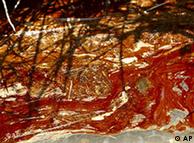Scientists create first synthetic cell
US scientists have created a cell controlled by a synthetic genome. They
say the method will help them investigate how life works and can be
used to create bacteria that can produce biofuels and clean the
environment.
Using four bottles of chemicals – each containing one of the four
building blocks of DNA – US scientists have built a million base pair
bacterium genome. This synthetic genome was then injected into a second,
closely related bacterium, where it took over the machinery of the
other bacterium, turning-out proteins and other cellular components for
the synthetic bacterium.
Dr J. Craig Venter, a genome-mapping pioneer, and his team announced
their breakthrough in a report published in the journal Science on
Friday. Speaking to reporters, Venter said that the synthetic genome
could be compared to computer software, while the cell itself is the
actual computer. The cell reads the updated software and starts
manufacturing something new.
 Bildunterschrift:
Großansicht des Bildes
mit der Bildunterschrift: Researchers
say this method could be used to make oil-eating bacteria Bildunterschrift:
Großansicht des Bildes
mit der Bildunterschrift: Researchers
say this method could be used to make oil-eating bacteria
Venter also said this approach is an order of magnitude different
than the standard procedure in synthetic biology, which usually involves
making molecular changes in less than a handful of genes.
Venter's colleague, Dr John Glass, told Deutsche Welle that this
technique also opens the door for more organisms to be used in synthetic
biology:
"There are many organisms that have properties that might make them
useful for industry, for pharmaceuticals, for the environment that we
have no genetic tools for. This organism that we work with, no genetic
tools at all essentially, and now this kind of work will enable great
discoveries, great advances to be made," he said.
Technological milestone
So is this research truly groundbreaking or is it just another tool
for biologists? Dr John Dueber, an assistant professor of
bioengineering at the University of California at Berkeley, told
Deutsche Welle it's a technological milestone.
Dueber sees advantages in being able to design a genome on a computer
and then building that genome from the ground-up, but doubts this will
immediately replace the technique that removes a single gene or adds a
few mutations:
"Both approaches have their merits and I don't think this replaces
those old techniques, I think they'll be used together in harmony," he
said.
Dueber also sees challenges ahead. One reason the synthetic genome
could take over the machinery in the other bacterium is that the two
bacteria are closely related. He said there is still some question as
to what would happen when a synthetic genome has more differences with
its potential target cell.
 Bildunterschrift: J. Craig
Venter, Ph.D. and Hamilton O. Smith, M.D. Bildunterschrift: J. Craig
Venter, Ph.D. and Hamilton O. Smith, M.D.
Fear factor and practical use
But discovery often goes hand in hand with risk and some people fear
synthetic organisms could escape from the laboratory and wreak havoc. To
prevent potential problems, the Venter Institute scientists eliminated
14 genes from the synthetic genome. Disabling the bacteria's ability to
infect the one animal it could - goats.
Doctor Venter admits that 99 percent of their experiments failed and
required debugging. They also plan to eliminate more genes so the
synthetic bacteria will only exist in the laboratory. Venter says the
scientists are keeping the potential problem in mind.
Beyond that, of course, there is the inevitable question: what are
the practical applications? The Venter Institute is working with Exxon
Mobil to develop new strains of algae that would capture carbon dioxide
to make new hydrocarbons that would be refined into gasoline or diesel.
The researchers also say this technique might be used for next
year's flu vaccine. That's because the Venter team says it can make a
flu vaccine in less than 24 hours. Though the scientists admit it would
take a serious flu pandemic for the US government to waive current
requirements.
Author: Laura Iiyama (mrm)
Editor: Stuart Tiffen http://www.dw-world.de/dw/article/0,,5597432,00.html
| 








